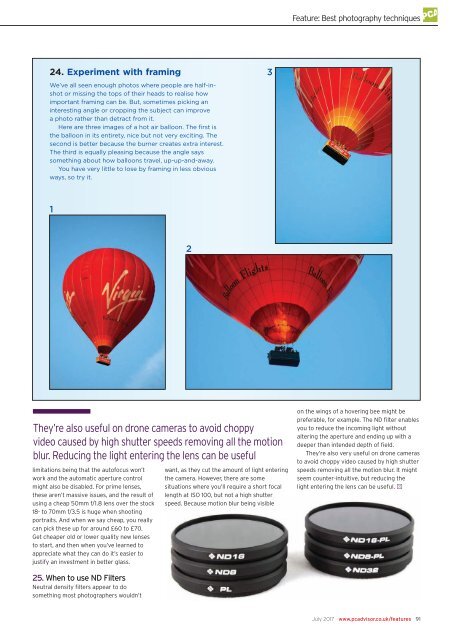You also want an ePaper? Increase the reach of your titles
YUMPU automatically turns print PDFs into web optimized ePapers that Google loves.
Feature: Best photography techniques<br />
24. Experiment with framing<br />
We’ve all seen enough photos where people are half-inshot<br />
or missing the tops of their heads to realise how<br />
important framing can be. But, sometimes picking an<br />
interesting angle or cropping the subject can improve<br />
a photo rather than detract from it.<br />
Here are three images of a hot air balloon. The first is<br />
the balloon in its entirety, nice but not very exciting. The<br />
second is better because the burner creates extra interest.<br />
The third is equally pleasing because the angle says<br />
something about how balloons travel, up-up-and-away.<br />
You have very little to lose by framing in less obvious<br />
ways, so try it.<br />
3<br />
1<br />
2<br />
They’re also useful on drone cameras to avoid choppy<br />
video caused by high shutter speeds removing all the motion<br />
blur. Reducing the light entering the lens can be useful<br />
limitations being that the autofocus won’t<br />
work and the automatic aperture control<br />
might also be disabled. For prime lenses,<br />
these aren’t massive issues, and the result of<br />
using a cheap 50mm f/1.8 lens over the stock<br />
18- to 70mm f/3.5 is huge when shooting<br />
portraits. And when we say cheap, you really<br />
can pick these up for around £60 to £70.<br />
Get cheaper old or lower quality new lenses<br />
to start, and then when you’ve learned to<br />
appreciate what they can do it’s easier to<br />
justify an investment in better glass.<br />
want, as they cut the amount of light entering<br />
the camera. However, there are some<br />
situations where you’ll require a short focal<br />
length at ISO 100, but not a high shutter<br />
speed. Because motion blur being visible<br />
on the wings of a hovering bee might be<br />
preferable, for example. The ND filter enables<br />
you to reduce the incoming light without<br />
altering the aperture and ending up with a<br />
deeper than intended depth of field.<br />
They’re also very useful on drone cameras<br />
to avoid choppy video caused by high shutter<br />
speeds removing all the motion blur. It might<br />
seem counter-intuitive, but reducing the<br />
light entering the lens can be useful. J<br />
25. When to use ND Filters<br />
Neutral density filters appear to do<br />
something most photographers wouldn’t<br />
<strong>July</strong> <strong>2017</strong> www.pcadvisor.co.uk/features 91


















